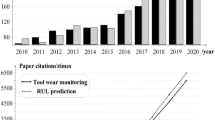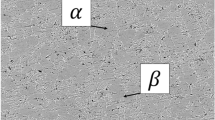Abstract
Flank wear occurs on the relief face of the tool and the life of a tool used in a machining process depends upon the amount of flank wear; so predicting of flank wear is an important requirement for higher productivity and product quality. In the present work, the effects of feed, depth of cut and cutting speed on flank wear of tungsten carbide and polycrystalline diamond (PCD) inserts in CNC turning of 7075 AL alloy with 10 wt% SiC composite are studied; also artificial neural network (ANN) and co-active neuro fuzzy inference system (CANFIS) are used to predict the flank wear of tungsten carbide and PCD inserts. The feed, depth of cut and cutting speed are selected as the input variables and artificial neural network and co-active neuro fuzzy inference system model are designed with two output variables. The comparison between the results of the presented models shows that the artificial neural network with the average relative prediction error of 1.03% for flank wear values of tungsten carbide inserts and 1.7% for flank wear values of PCD inserts is more accurate and can be utilized effectively for the prediction of flank wear in CNC turning of 7075 AL alloy SiC composite. It is also found that the tungsten carbide insert flank wear can be predicted with less error than PCD flank wear insert using ANN. With Regard to the effect of the cutting parameters on the flank wear, it is found that the increase of the feed, depth of cut and cutting speed increases the flank wear. Also the feed and depth of cut are the most effective parameters on the flank wear and the cutting speed has lesser effect.










Similar content being viewed by others
References
Bhushan RK, Kumar S, Das S (2010) Effect of machining parameters on surface roughness and tool wear for 7075 Al alloy SiC composite. Int J Adv Manuf Technol. doi:10.1007/s00170-010-2529-2
Palanisamy P, Rajendran I, Shanmugasundaram S (2008) Prediction of tool wears using regression and ANN models in end-milling operation. Int J Adv Manuf Technol 37:29–41
Sharma VS, Sharma SK, Sharma AK (2008) Cutting tool wear estimation for turning. J Intell Manuf 19:99–108
Chandrasekaran M, Muralidhar M, Murali Krishna C, Dixit US (2009) Application of soft computing techniques in machining performance prediction and optimization: a literature review. Int J Adv Manuf Technol. doi:10.1007/s00170-009-2104-x
Chen JC, Chen JC (2005) An artificial-neural-networks-based in-process tool wears prediction system in milling operations. Int J Adv Manuf Technol 25:427–434
Jemielniak K, Kwiatkowski L, Wrzosek P (1998) Diagnosis of tool wear based on cutting forces and acoustic emission measures as inputs to a neural network. J Intell Manuf 9:447–455
Seeman M, Ganesan G, Karthikeyan R, Velayudham A (2009) Study on tool wear and surface roughness in machining of particulate aluminum metal matrix composite-response surface methodology approach. Int J Adv Manuf Technol. doi:10.1007/s00170-009-2297-z
Haber RE, Alique A, Alique JR (2002) Tool wear prediction in milling using neural networks. ICANN 2002, LNCS 2415, pp 807–812
Dong J, Subrahmanyam KVR, Wong YS, Hong GS, Mohanty AR (2006) Bayesian-inference-based neural networks for tool wear estimation. Int J Adv Manuf Technol 30:797–807
Ming L, Xiaohong Y, Shuzi Y (1999) Tool wear length estimation with a self learning fuzzy inference algorithm in finish milling. Int J Adv Manuf Technol 15:537–545
Kumanan S, Jesuthanam CP, Ashok Kumar R (2008) Application of multiple regression and adaptive neuro fuzzy inference system for the prediction of surface roughness. Int J Adv Manuf Technol 35:778–788
Dweiri F, Al-Jarrah M, Al-Wedyan H (2003) Fuzzy surface roughness modelling of CNC down milling of Alumic-79. J Mater Process Technol 133:266–275
Caydas U, Hascalik A, Ekici S (2009) An adaptive neuro-fuzzy inference system (ANFIS) model for wire-EDM. Exp Sys with Appl 36:6135–6139
Mat darus IZ, Tokhi MO (2005) Soft computing-based active vibration control of a flexible structure. Eng Appl Artif Intel 18:93–114
Gölo˘glu C, Arslan Y (2009) Zigzag machining surface roughness modelling using evolutionary approach. J Intell Manuf 20:203–210
Tsai KM, Wang PJ (2001) Predictions on surface finish in electrical discharge machining based upon neural network models. Int J Mach Tools Manuf 41:1385–1403
Wong JT, Chen KH, Su CT (2008) Designing a system for a process parameter determined through modified PSO and fuzzy neural network. PAKDD 2008, LNAI 5012, pp 785–794
Tsai KM, Wang PJ (2001) Comparisons of neural network models on material removal rate in electrical discharge machining. J Mater Process Technol 117:111–124
Li X, Guan X, Li Y (2004) A hybrid radial basis function neural network for dimensional error prediction in end milling. ISNN 2004, LNCS 3174, pp 743–748
Uros Z, Frank C, Edi K (2009) Adaptive network based inference system for estimation of flank wear in end-milling. J Mater Process Technol 209:1504–1511
Balazinski M, Czogala E, Jemielniak K, Leski J (2005) Tool condition monitoring using artificial intelligence methods. Eng Appl Artif Intell 15:73–80
Gajate1 A, Haber RE, Alique JR, Vega PI (2009) Transductive-weighted neuro-fuzzy inference system for tool wear prediction in a turning process. HAIS 2009, LNAI 5572, pp 113–120
Kuo RJ (2000) Multi-sensor integration for on-line tool wears estimation through artificial neural networks and fuzzy neural network. Eng Appl Artif Intell 3:49–261
Achiche S, Balazinski M, Baron L, Jemielniak K (2004) Tool wears monitoring using genetically-generated fuzzy knowledge bases. Eng Appl Artif Intell 15:303–314
Hardalac F et al (2004) The examination of the effects of obesity on a number of arteries and body mass index by using expert systems. J Med Syst 28:129–142
Dinh NQ, Afzulpurkar NV (2007) Neuro-fuzzy MIMO nonlinear control for ceramic roller kiln. Simu Model Prac Theo 15:1239–1258
Saemi M, Ahmadi M (2008) Integration of genetic algorithm and a coactive neuro-fuzzy inference system for permeability prediction from well logs data. Transp Porous Med 71:273–288
Mintz R, Young BR, Svrcek WY (2005) Fuzzy logic modeling of surface ozone concentrations. Comp Chem Eng 29:2049–2059
Camps-Valls G et al (2003) Support vector machines for crop classification using hyperspectral data. IbPRIA 2003, LNCS 2652, pp 134–141
Chen J, Roberts C, Weston P (2008) Fault detection and diagnosis for railway track circuits using neuro-fuzzy systems. Cont Eng Prac 16:585–596
Aytek A (2009) Co-active neurofuzzy inference system for evapotranspiration modeling. Soft Comput 13:691–700
Singh TN, Verma AK, Sharma PK (2007) A neuro-genetic approach for prediction of time dependent deformational characteristic of rock and its sensitivity analysis. Geotech Geol Eng 25:395–407
Antony J (2003) Design of experiments for engineers and scientists. ISBN: 0750647094. Elsevier Science & Technology Books
Lippman RP (1987) An introduction to computing with neural nets. IEEE ASSP Mag 4:4–22
Anderson D, McNeil G (1992) Artificial neural network technology. Kaman Sciences Corporation
Klimasauskas CC (1991) Neural computing. Neural–Ware, Pittsburgh
Author information
Authors and Affiliations
Corresponding author
Rights and permissions
About this article
Cite this article
Zare Chavoshi, S. Tool flank wear prediction in CNC turning of 7075 AL alloy SiC composite. Prod. Eng. Res. Devel. 5, 37–47 (2011). https://doi.org/10.1007/s11740-010-0282-x
Received:
Accepted:
Published:
Issue Date:
DOI: https://doi.org/10.1007/s11740-010-0282-x




